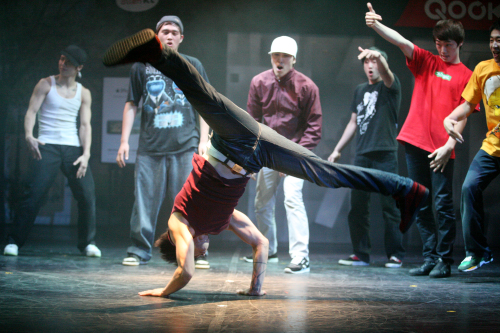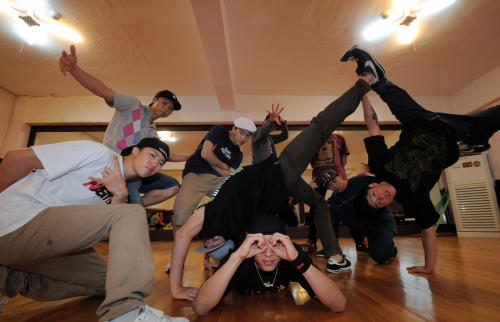Lack of new b-boy generation, fewer shows signal uncertain future for break-dancing
Break-dancing has pretty much infiltrated every aspect of popular culture in Korea.
People can catch breakers showcasing their hip moves on television, in musicals, competitions and ads.
The arresting visual allure of those acrobatic stunts, of the combination of swift ground work with powerful up-ended twirls and twists makes it is easy to see why everyone is so mesmerized by break-dancing, and, therefore, why it is so popular here.
It certainly doesn’t hurt that Korean b-boy crews have been winning major international competitions or that celebrities like Jay Park have brought the art to the forefront.
From where it stands, it looks like b-boying has a bright future.
Then again, when a dance style has saturated mass media to the point that b-boying has, there is a chance that viewers might tire of it, be less wowed by the by-now standard windmill or jackhammer.
They might start changing the channel or picking a different act to check out.
Sure, the boys might be bringing home the trophies, but after having done so for a decade, it might grow old.
In short ,the b-boying trend might just have peaked.
Veteran b-boy-and-actor Oh Se-bin, one of the founding members of the famed Gambler Crew, thinks that this year will prove crucial for b-boying in Korea.
“The future has become very frightening for b-boys,” he said. “I think right now is a time of concern for them.”
According to Oh, b-boying first took root in Korea in the early 90s, developing and growing underground.
It wasn’t until 2001, when a Korean b-boy team nabbed a global award that people started to take notice. Then, in 2002, a Korean crew won the internationally-famed Battle of the Year title. By 2003, b-boying was no longer a silent phenomenon.
“That time was golden, because all this hidden talent just exploded onto the scene,” the 29-year old said. “Suddenly, Korean b-boys got major, globally.”
 |
The non-verbal musical show “Ballerina Who Loves B-boy” — which melds ballet with break-dancing — is still going strong after a six-year run. (Showbboy) |
Shortly afterwards, in 2005, a non-verbal show called “Ballerina Who Loves B-boy” opened, helping pave a new stage for b-boys, connecting them to the masses.
“I wanted to take b-boying and mesh it with classical ballet,” said “Ballerina Who Loves B-boy” creator Choi Yoon-yeob. “I wanted to ask audiences if they felt it had artistic value.”
Apparently, they did.
The show was a hit and went on to play at the Edinburgh Fringe Festival in Scotland in 2007 and in New York in 2008, beginning a new global chapter for the popular show.
As “Ballerina Who Loves B-boy” grew increasingly successful, more and more shows featuring b-boys sprung onto the circuit.
Now, b-boys weren’t restricted to the street or competitions, they had the theater too.
“In 2005, people were shocked and excited by b-boying,” Choi explained how it was in the beginning. “Then, people started to see b-boys as stars.”
Choi described how the change in public perception affected the way b-boys saw themselves.
“They got cocky.”
Oh agreed that b-boys got arrogant.
“Life was hard,” Oh explained how it all came about. “Then suddenly we got rich. All these businesses approached us and we became stars.”
Just as breakers were adjusting to their fame, the bubble burst.
“If there were around 1,000 shows running, now there are 10,” said Oh.
Oh ― who himself is currently starring in a show that features b-boying, Walkerhill Theatre’s “Legend of Flower” ― says that the whittling down of shows has fostered a period of anxiety for b-boys.
Oh takes an optimistic approach to the situation and believes that it is getting b-boys to come together, return to their roots and rekindle any potentially dampened passions.
One thing is for certain, however, while the number of b-boy-centric shows may have decreased that does not mean that b-boys have gone back to square one.
The Korean b-boy scene has changed, for good.
Even if b-boys are not necessarily nabbing lead roles, they still appear in various musicals and shows. They are still winning medals abroad. Not to mention, they are also making appearances on TV shows.
 |
Hot property Jinjo Crew strike a pose in their studio in southern Seoul on Wednesday (fromleft to right, front to back) — Soma, Stony, Skim, Wing, Mold, Fleta, F.E., Octopus and Vero(Ahn Hoon/The Korea Herald) |
Take Jinjo Crew, for instance.
Founded in 2001, the current 10-member group took home the much-coveted Battle of the Year title last year. Two members, Skim and Wing, also recently got airtime on the TV reality show “Korea’s Got Talent.”
“I think Jinjo Crew is good,” Oh gave them props. “I feel like their work is three-dimensional and creative.”
In Oh’s opinion, Jinjo is heading in the right direction.
“B-boys need to tone down their attitude and get smart,” he said. “Jinjo does this.”
Indeed, Jinjo (which means “Rising Fire” in English) seems to represent a new breed of crew.
Back in the day, according to Oh, b-boying in Korea was more-or-less a street dance movement, just how it was when it first started out in the South Bronx in the late ‘70s.
There were no places to practice, so crews would perform in subway stations. Some even claimed certain stations as their turf, said Oh. When it came time to clash, everyone would round up in Daehak-ro to battle.
Jinjo, by comparison, is a slick operation. The crew has its own studio down in southern Seoul. It also has a website and a Facebook and Twitter account. The crew even has its own manager.
It is hard to tell how much influence all this has on Jinjo’s impressive winning streak, but this much is clear, they are well-organized, and judging from the trophies lining the shelves in the studio, it certainly isn’t hurting their performance.
While Jinjo Crew might represent hope for the future of b-boying in Korea, Jinjo leader Skim (real name Kim Heon-jun) thinks there is a dearth of new generation b-boys right now.
“Lots of kids try it out and then quit,” the 25-year-old stressed the lack of beginners who are willing to stick it out to the end.
On the upside, Jinjo has a group of boys training under them that are looking to join the crew, and according to Skim “b-boys are more modest now because they know modesty will bring in the cash.”
Skim put in his own two cents on the future of b-boying.
“I feel like b-boys need to study and research the performance show side of the business,” said Skim.
Indeed, it looks like the theater show is a key genre for b-boys to keep up a mainstream connection to the masses.
Choi, who christened his production company Showbboy because he believes that break-dancing is where it is at, revealed that he is preparing to release a second show that will feature b-boying.
“Break-dance is evolving and getting more systematized throughout the world,” Choi stressed his belief that b-boying is far from over.
According to b-boy Oh, there are currently around 10 high profile crews and around 300 b-boy teams nationwide, a sure sign that b-boying is alive and well, though Oh says there were more in the past.
Where are they heading?
Jinjo, at least, is intent on raising the bar.
In Jinjo member Wing’s opinion, Korean b-boys have yet to really be the greatest in the world.
“There are a lot of other great b-boys out there, they just don’t enter those competitions,” said the 23-year-old, who has been at it for 13 years and counting.
“We don’t see ourselves as the best crew in the world,” he added.
Having just nabbed top honors for the R-16 Korea tournament, the crew is going on to four more major international competitions from late August through November.
“Just participating in all four of these competitions is very historic in itself,” said Skim.
Right now, Jinjo is going strong, but just how long will it last?
According to Oh, the average performing peak of a b-boy runs from age 16 to 26. Skim and Wing, however, show no signs of retiring anytime soon.
“We want to keep doing competitions forever,” said Skim.
The crew leader grinned and leaned back. He needed to speak no further. His shirt said it all: “B-boy For Life.”
By Jean Oh (
oh_jean@heraldcorp.com)









